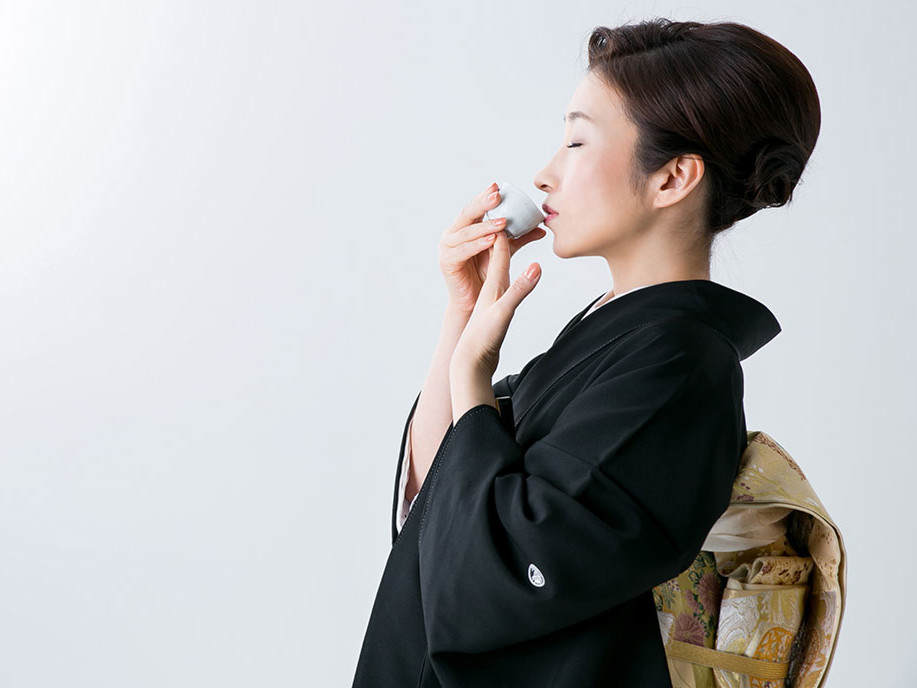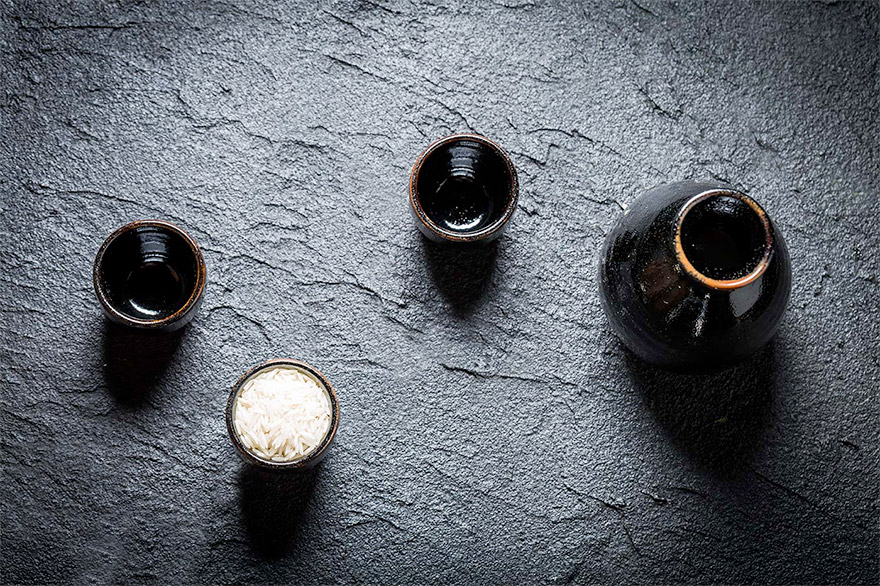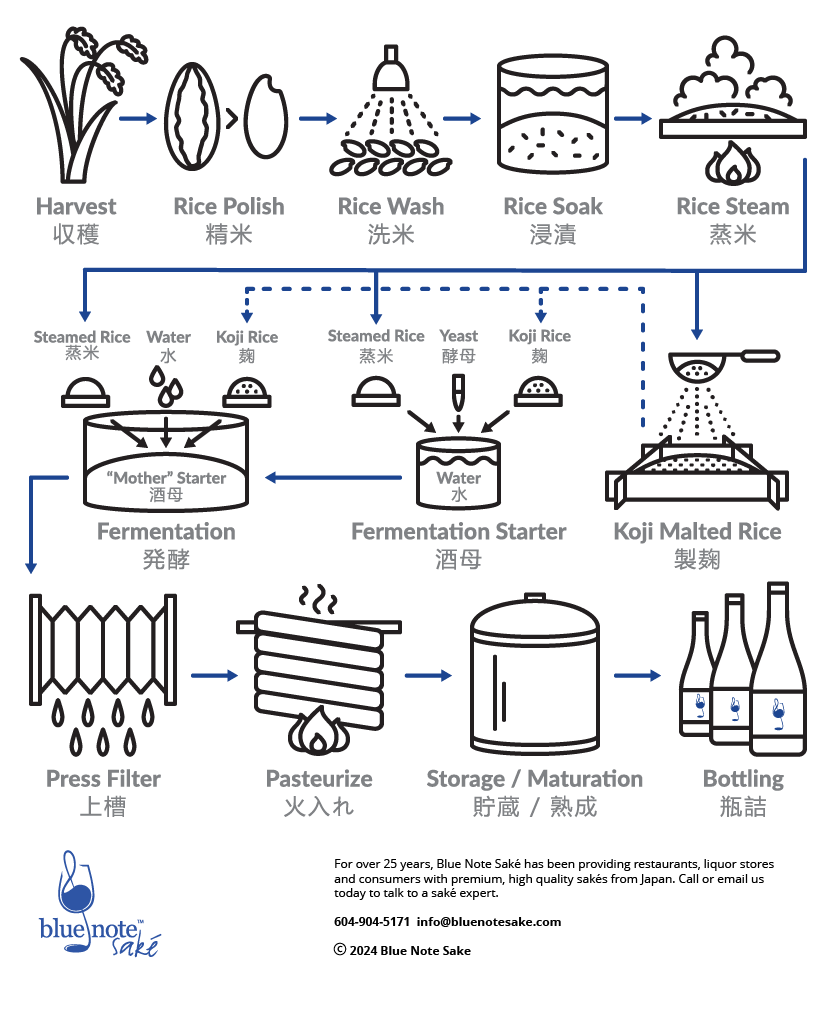
"The sweet aromas of fresh steamed rice, wafts of ripened honeydew melon, followed with lush, creamy waves of layers of caramel cake interlaced with soft fennel."
How can all these flavours be experienced through a single sip?

Crafted with only a few simple ingredients, saké is arguably one of the purest alcohol beverages in the world. It is the skilled techniques of the craft brewmaster at every step of the process who bring the ingredients to life.
The brewmaster controls the entire process, from determining the amount of rice polish to the duration of soaking, to defining the ‘Moto’ (mother starter) technique, to the filtration and pressing style, and lastly, the pasteurization. All these decisions can significantly impact the ultimate profile of the saké.
All that said, most would agree that the Koji development is the most significant step in the entire saké production process.
In a dedicated, strictly controlled environment, the Koji inoculation process is where the starch is converted to sugar. Not only is this sugar conversion (saccharification) necessary for alcohol production, but the manner in which it is developed has a tremendous bearing on how the final saké will reveal itself.
QUICK SAKÉ FACTS
Saké in Japan has a rich history dating back 1400 years. Today, there are still over 1,000 brewers producing saké.
Premium saké drinks like a wine and is best enjoyed chilled in a wine glass.
Alcohol levels in saké are similar to wine : 12% to 18% alc./vol.
Saké is not distilled. It is brewed like a beer, but fermented through a more complex “multiple-parallel fermentation” process.
Premium sakés are classified by the amount of rice that has been polished away from the grain. Generally, the more rice has been polished, the more refined the saké.
Saké is a food-pairing dream as it has much less acidity than wine. Also, the high level of amino acid in saké amplifies the umami, enhancing food flavours. An old Japanese proverb says “Saké does not fight with food.” Classic wine & food pairing challenges can be easily solved with saké.
Saké is chock-full of ‘umami.’ Discovered over a hundred years ago, umami is one of the 5 basic tastes, along with salty, sweet, bitter, and sour. The umami taste receptors are in the centre area of the tongue. Umami is the flavour sensation that is used to describe foods that are “rich and savoury,” such as cheese, tomatoes, mushrooms, miso, soya sauce, gravy, etc.
The starch in saké rice is concentrated as the white heart (‘shinpaku’) in the centre of the grain vs. that of table rice which has starch dispersed throughout the grain, intermixed with fats, lipids and proteins. Polishing the outer part of the saké rice grain removes these less desirable components, resulting in a smoother saké.
There are more than 100+ saké rice varieties. Each presents its own unique flavour and character profile. Similar to wine grapes, while there are many choices available, most saké breweries focus on the top 5, with the Yamada Nishiki variety recognized as the ‘king’ of saké rice.
Lactic acid plays a critical role in the saké brewing process. This, along with saké’s prominent umami character makes it a natural pair for creamy French dishes, Italian classics like pizzas and pastas, and North American comfort foods, from gumbo to poutine!
Saké Education
The Process
Discover how saké is crafted through it’s unique multiple-parallel fermentation process.
Saké Speak
A quick reference guide to the key terms you will discover on your journey through the world of saké.
This extensive list covers includes types and styles, production terms, and general saké references.
Saké Videos
Grab a chilled glass of saké and cozy up to insights and scenes from some of our producers.
Our video library will continue to expand, so be sure to check back often.
Saké Speak
Key terms you will discover on your journey through the world of saké, including styles, production terms, and general saké references.
Amakuchi 甘口 (‘sweet mouth’) : Saké descriptor for those with sweeter taste profile.
Amazake 甘酒 (‘sweet saké) : There are 2 Types of amazake : (1 ) Non-alcohol (<1% alc.) is produced by mixing steamed rice and rice-koji; (2) made by mixing saké kasu (lees from pressing) with water. Saké lees have some residual alcohol, giving the amazake an alcohol level up to 7% alc.
Aru-ten アル添 (‘alcohol added’) : Alcohol is added to enhance the flavour profile by amplifying the aromas and flavours. It is added after fermentation, just before pressing.
Aspergillus Oryzae 麹菌 : Biological term for the ‘Koji’ mold.
Atsukan 熱燗 (‘heated’) : Heated saké (50°).
BinKan Hi-ire 瓶燗火入れ : In-bottle pasteurization.
Bodaimoto 菩提酛 (‘Bodai starter’) : An ancient saké style circa 14th Century, developed by Buddhist monks. The process is different to Kimoto in that it combines raw polished rice, with steamed rice (first cooled in open air so it may become yeast infected) and water and then incubated for 3 days. Also, compared to Kimoto sakés, Bodaimoto is heavier and notably sweeter and more sour, yet usually followed by a fairly clear, dry finish.
Choko 猪口 (‘boar’s mouth) : Small (45ml), shallow traditional saké cup. Typically, ceramic or earthenware.
Dai-Ginjo 大吟醸 (‘great ginjo’) : Daiginjo Saké is a special designation saké (‘Tokutei Meishoshu’), made from rice grain polished minimum 50%.
Fukuro Tsuri 袋吊り(‘bag drip’) : The most gentle of saké pressing processes, where it is poured into mesh bags, then hung, using gravity to naturally draw the liquid through the bag. The process is gentle, yet very time consuming and labour intensive, so it usually reserved for more exclusive, rarer sakés. Also referred to as Shizuku (‘drip’).
Fune Shibori 槽搾り(‘vessel pressing’) : A traditional long, rectangular shaped container used to filter/press the mash (‘moromi’) to separate the solids (‘kasu’) from the liquid. Porous bags are filled with the mash then gently laid horizontally on top of each other, creating a gentle pressure to squeeze out the liquid which is collected through a drain in the bottom. The box-like vessel resembles the shape of a boat (‘fune’).
Futsu-shu 普通酒 (‘regular saké) : Often referred to as ‘table’ or ‘house’ saké. Futsu-shu is usually made with a rice polish of less than 70%, and/or made with added ingredients other those approved for the specially designated saké (‘Tokutei Meishoshu’).
Genmai玄米 (‘original rice’) : Unpolished raw rice.
Genshu 原酒 (‘original saké) : Original alcohol strength saké that has not been diluted with water. Pre-dilution, saké typically brews to around 18% alc./vol., however, some brewers craft their Genshu to 15% – 16%.
Ginjo 吟醸 (‘select ingredient brew’) : A special designation saké (‘Tokutei Meisho-shu’) which is made from rice polished to at least 60% (40% grain removed). If there is not a Junmai prefix, then brewer’s alcohol has been added. Ginjo also refers to the character profile having more fragrant aromatics, created by fermenting at lower temperatures so the yeast produces fruity and floral aromas (“ginjo-ka”).
Gohyaku Mangoku 五百万石 (‘5 million stones’ ): The 2nd most popular saké rice varietal which gives a more crisp, yet gentle saké with mild flavour profile.
Guinomi ぐい吞み (‘gulp drink’) : Saké cup that is a larger version of the traditional, smaller ochoko cup.
Happo Seishu 発泡清酒 (‘bubble saké’) : Sparkling saké.
Hatsuzoe 初添 (‘1st addition’) : The first day where koji, rice, and water is added to the shubo (yeast starter).
Hazé 破精 (‘break spirit’) : The spotty pattern of koji mold growth that have spread out over the grains of steamed rice.
Heiko Fuku Hako 平行複発酵 (‘multiple-parallel fermentation’) : The type of fermentation by which saké is produced, where starch is converted to sugar (saccharification) and sugar (with yeast) is then converted to alcohol. This unique fermentation takes place simultaneously in parallel, in the same tank.
Hineka 老香 (‘old smell’) : An unpleasant aroma that can develop in aged saké that is stored beyond its years or at warmer temperatures.
Hiochi(kin) 火落ち(菌) (‘heat drop bacteria’) : A type of lactic acid bacteria which when excessively fermented gives a brownish hue and sulphur-like aromas. Its ability to survive higher levels of alcohol and acidity is dreaded by brewers who turn to pasteurization to avert the impact of the bacteria.
Hi-ire 火入れ (‘add heat’) : Pasteurize (typically 60 °C+).
Hiya Oroshi 冷卸し (‘cold transfer’) : Special Autumn saké that has been pasteurized once and stored until the autumn, when it is shipped without a 2nd pasteurization. It is also called Aki-agari or Nama-zume.
Honjozo 本醸造 (‘true brewed saké’) : Honjozo type Saké is made from rice grain polished to minimum 70% (30% grain removed) with a small amount of brewer’s alcohol added. Enjoyed chilled or warmed, Honjozo is a lighter, more refreshing and fragrant style, which pairs easily with a wide range of foods.
Ichigo 一合 (‘1 meeting’) : Japanese saké unit of measurement equal to 180ml. This size is based on the traditional square wooden rice measuring cup (‘masu’).
Issho 一升 (‘1 measurement’) : Japanese saké unit of measurement equal to 1.8L (10 x ichigo).
Jizaké 地酒 (‘local saké) : A general term for local or regional saké. While there is no formal definition, it often refers to smaller, artisanal brewers.
Junmai 純米 (‘pure rice’) : Junmai saké is made from only the 4 core ingredients – water, rice, koji-kin and yeast. Unlike the other official categories of Tokutei Meisho-shu, basic Junmai Sakés have no minimum rice polishing levels. The term Junmai is also used as an adjective for other saké categories to indicate there has been no alcohol added, such as Tokubetsu (Special) Junmai, Junmai Ginjo, and Junmai Dai-Ginjo. Basic Junmai sakés, with lower rice polish tend to reveal more earthy, mineral and rice tones.
Junmai Daiginjo 純米大吟醸 (‘pure rice Dai-Ginjo’) : Saké made from minimum 50% rice polish and without brewer’s alcohol.
Junmai Ginjo 純米吟醸 (‘pure rice Ginjo’) : Saké made from minimum 40% rice polished away and without brewer’s alcohol.
Kagami-biraki 鏡開き (‘mirror breaking’) : A ceremony similar to a christening, where the wooden lid of a saké barrel is smashed open with a hammer. The lid is shaped like a mirror, giving it this name.
Kai 櫂 (‘paddle’) : A long wooden tool, shaped like an oar that is used to stir the shubo and moromi.
Kake-mai掛け米 (‘applied steamed rice’) : Steamed rice that has been designated to be added to the brew mash (moromi).
Kampai 乾杯 (‘empty the glass’) : Traditional toast in Japan. Cheers!
Kanzake 燗酒 (‘heated saké’) : Saké that has been heated, ranging in temperature from luke-warm to very hot.
Karakuchi 辛口 (‘dry mouth’) : Dry taste profile.
Kasu 粕 (‘residue’) : Saké lees (solids) that remain from the pressing filter.
Kijo-shu 貴醸酒 (‘elite brew’) : A sweet saké that uses saké instead of water in the final stage of the fermentation process.
Kiki-choko 利き猪口 (‘tasting cup’) : A special choko (cup) made for professional tasting. It usually has blue bullseye-like circles painted in the bottom that help reveal some quality structure of the saké.
Kimoto 生酛 (‘live starter’) : Classic style of saké brewing which produces a rich, heavy, sometimes wild and funky saké with higher acidity. This labour-intensive method utilizes natural lactic acid bacteria generated in the shubo (starter) to alter the acidity levels so the yeast can thrive while inhibiting unwanted bacteria. This traditional production method was the norm until the 20th century, when a more efficient process (sokujo) was developed.
Kobo 酵母 (‘mother of sake’) : Yeast.
Koji 麹 (‘molded’) : Steamed rice that has been inoculated with the koji-kin mold spores that produce enzymes which break down starch into glucose.
Koji-kin 麹菌 (‘aspergillus oryzae’) : Small organisms that are core to producing saké, shochu, and miso.
Koji-mai 麹米 (‘steamed rice for molding’) : Steamed rice designated to be used to make koji.
Koji-muro 麹室 (‘molding room’) : The exclusive room where koji is made. This room is specially designed to allow the brewer to critically control moisture and heat in order to control the koji mold growth.
Koku 石 (‘stone’) : Brewery production size is usually described in number of koku units. 1 koku equals 180L.
Koshi Tanrei 越淡麗 : A hybrid saké rice variety recently developed in Niigata by crossbreeding the top 2 saké rice varieties Yamada Nishiki and Gohyaku Mangoku.
Koshiki 甑 (‘steamer’) : The vessel used for steaming rice, traditionally made from Japanese cypress (sugi) wood.
Koshu 古酒 (‘old saké’) : Aged saké.
Kosui 硬水 (‘hard water’) : Hard Water having more mineral content, often lending to more full-bodied sakés.
Kura 蔵 (‘brewery’) : Saké brewery.
Kurabito 蔵人 (‘brewery person’) : Brewery workers.
Kuramoto 蔵元 (‘brewery owner’) : Brewery owner.
Kyokai Kobo 協会酵母 (‘association yeast’) : Proprietary yeasts that are researched, developed and distributed by the Brewing Society of Japan (Nihon Jozo Kyokai).
Matsuo Taisha 松尾大社 (‘Mastuo Grand Shrine’) : A shrine in Kyoto that is revered as the holy place that houses the god that guides saké brewing.
Miki / O-miki-zake お神酒 (‘gods’ saké’) : A Shinto ritual offering saké to the gods.
Mirin味醂 (‘sweet saké’) : Sweet saké often used for cooking. Mirin is made by mixing rice koji and steamed rice into a base of shochu and fermenting for 1-2 months. Like saké, mirin is filtered/pressed, but has considerably less to no alcohol.
Mizumoto 水酛 (‘water starter’) : One of the oldest methods of producing the shubo (fermentation starter) as developed in the temples in Japan. The most famous type of mizumoto is bodaimoto.
Moromi 醪 (‘saké mash) : The main fermentation mash where all the ingredients needed for saké production have been added together into a large tank.
Moto 酛 (‘base of saké’) : Also known as the shubo (‘seed’), yeast starter. A small starter lot that invigorates a concentration of yeast activity needed for saké production when transferred to the larger fermentation tank.
Muroka 無濾過 (‘no filter’) : While the literal meaning is ‘no filter’, most breweries use this term to refer to saké that has no charcoal fining.
Nama-chozo生貯蔵 (‘raw storage’) : Saké that is once pasteurized just prior to shipping, after being stored unpasteurized for a period of time. This unpasteurized storage and single pasteurization gives a fresher, more pronounced profile than the usual double pasteurized sakés.
Namazake 生酒 (‘raw saké’) : Unpasteurized saké which has fresher, lively flavours and often nutty aromas. As this saké has not be stabilized through pasteurization, it should never be stored nor shipped without refrigeration.
Nansui 軟水 (‘soft water’) : Soft water with less mineral content, often producing a gentler, smoother saké.
Nigori Sakéにごり酒 (‘cloudy saké’) : Saké with some sediment (lees) remaining, giving the saké a cloudy-like appearance. Due to the density of the Nigori, the sediment will settle to the bottom, so it should always be gently shaken when serving.
Nihonshu 日本酒 (‘Japanese alcohol’) : The term for Japanese saké.
Nihonshudo日本酒度 (‘Japan saké level’) : Referred to as the Saké Meter Value (SMV), this scale is a rough indicator for the sweetness ( – ) or dryness ( + ) of a saké. The value is specifically the measure of the saké’s density in water (specific gravity), so while it is not an exact sweetness measurement, it sometimes offers an indication of sweetness/dryness levels.
Nurukan ぬる燗 (‘warm heating’) : Warm saké (40°C).
Nyusan 乳酸 (‘lactic acid’) : An organic acid critical as it which represses contaminants, creating a more stable environ to encourage a healthy yeast development needed for saké production.
(O)Choko お猪口 (‘small ware’) : Small traditional 45ml saké cup, usually ceramic or glass.
Odori 踊り(‘dance’) : The 2nd day of the 3rd stage of saké production where there is no additions. It is considered day of ‘rest’ to allow the yeast to propagate and grow and, dance!
Okute奥手 (‘late growing’): The term for rice varieties that are planted and harvested later in the season. Typically, these have larger grains and produce a fuller bodied saké. Okute varieties include Yamada Nishiki and Omachi.
Omachi 雄町 : This signature rice of Okayama prefecture is one of the few remaining original heirloom ‘pure’ rice strains still in cultivation. Omachi is difficult to grow due to its considerable stalk height, leaving it susceptible to strong winds, and is difficult to machine harvest.
Reishu 冷酒 (‘cold saké’) : Saké served chilled.
Roka濾過 (‘filtration’) : The 2nd stage of filtration (the first being ‘assaku’ – moromi compression). Roka stage can use paper, cloth and/or other medium (such as charcoal) to filter remaining solids to clarify the saké.
Sakamai 酒米 (‘saké rice’) : Rice varieties that are specifically grown for saké production. While there are well over 100 varieties of saké-specific rice, less than 5% of total Japan rice cultivation is sakamai.
Sandan Jikomi 三段仕込み (‘3 stage preparation’) : The term used to describe the typical 3 stage saké brewing process. This modern method was developed in the Muromachi era (1336-1573). In essence, when brewing saké, adding too many ingredients too quickly risks overwhelming the yeast. Over time it was realized the gradual addition of ingredients allowed for more control of the fermentation process, especially the management of yeast acidity, ultimately producing a better flavour and balanced saké.
The 3 Stages are broken into these segments:
Day 1 : Stage 1 ‘Hatsu-zoe’ (‘start addition’) 2 parts Koji to 3 Kake Mai
Day 2 : ‘Odori’ (‘rest’) no ingredients added
Day 3 : Stage 2 ‘Naka-zoe’ (‘middle addition’) 1 part Koji to 2 parts Kake Mai
Day 4 : Stage 3 ‘Tome-zoe’ (‘end addition’) 1 part Koji to 5 parts Kake Mai
Sando 酸度 (‘acid degree’) : The number that indicates the levels of organic acids giving the saké acidic and umami flavours.
Seimai buai 精米歩合 (‘polished rice ratio’) : The amount of the original rice grain remaining after it has been polished. This number indicated in %, is commonly noted on the labels and in saké descriptions.
Seishu 清酒 (‘clear saké’) : The legal industry term for saké in Japan. Note, that while the literal character translation is ‘clear saké’ the category still includes Nigori (’cloudy’) style saké.
Shibori 搾り(‘press’) : The pressing of saké.
Shibori tate 搾りたて (‘just pressed’) : Freshly filtered, unpasteurized saké.
Shinpaku 心白 (‘white heart’) : The concentration of white starch core in the centre of the saké rice grain.
Shinseki 浸漬 (‘soaking’) : The soaking of rice prior to steaming. The rate of absorption may be affected by the rice variety, temperature and type of water.
Shinshu 新酒 (‘new saké’) : Fresh, newly made saké.
Shizuku 雫 (‘drip’) : The most gentle of saké pressing methods, where saké is poured into mesh bags, then hung, using gravity to naturally draw only the liquid through the bag. The process is gentle, yet very time consuming and labour intensive, so it usually reserved for more exclusive, rarer sakés. Also referred to as Fukuro Tsuri.
Shubo 酒母 (‘saké mother’) : The saké yeast starter used in brewing, also known as moto.
Shuzo 酒造 (‘brewery’) : Term often used by a saké producer as part of their company name.
Shuzo Nendo 酒造年度 (‘brewing year’) : The year to indicate which brewing season the saké’s production began (regardless of when actually completed). The brewing year (“BY”) runs from July 1, through to June 30, the following year.
Sokujo 速醸 (‘speedy starter’) : The ‘modern’ method of making the shubo where lactic acid is added to the mix before the yeast is added.
Sugidama 杉玉 (‘Japanese cedar ball’) : A ball made of boughs from the cryptomeria tree (similar to cedar), approximately 40cm dia. It is hung outside the brewery representing the start of the new brewing season.
Tanrei Karakuchi 淡麗辛口 (‘smooth clean dry‘) : Saké descriptor meaning dry, crisp and clean. Often used to describe Niigata style saké.
Taruzake 樽酒 (‘barrel saké’) : Wooden casks used to store or age saké, giving a cedar wood-like flavour finish.
Toji 杜氏 (‘master brewer’) : The head of the brewery who manages the brewery workers.
Tokkuri 徳利 (‘saké flask’) : A tall, thin carafe used to warm and serve saké. It has a small mouth opening and is usually made from ceramics or earthenware.
Tokubetsu 特別 (‘special’) : For saké, it denotes a special care given to a saké beyond its typical classification, often referring to rice polish. There is no standard, legal definition in the saké industry for specifications.
Tokutei Meisho-shu 特定名称酒 (‘special designation saké’) : The official Government grade list distinguished by rice polish ratio and/or addition of brewers alcohol. Less than 30% of all saké produced in Japan is Tokutei Meisho-Shu. The remaining 70%+ is Futsu-shu (regular or ‘unclassified’ saké). Saké classification categorizes these ‘premium’ sakés into 8 grades: Junmai Daiginjo, Daiginjo, Junmai Ginjo, Ginjo, Junmai, Tokubetsu Junmai, Honjozo, and Tokubetsu Honjozo.
Umami 旨味 (‘delicious flavour’) : One of the 5 basic tastes (along with sweet, sour, bitter, salt). Discovered by Japanese chemist (Kikunae Ikeda) a century ago, Umami has only recently entered the English language. Often described as rich and savoury, you can taste umami in foods that contain a high level of amino acid glutamate, such as miso, parmesan cheese, seaweed, tomato sauce and mushrooms.
Wase 早生 (‘early born’) : Rice varieties that are planted and harvested early. Popular wase varieties include Gohyaku Mangoku and Miyama Nishiki.
Yabutaやぶた : The brand name for the most popular automatic accordion press, used in the initial pressing phase of brewing process.
Yamada Nishiki 山田錦 : The ‘king of saké rice’ is the most popular variety and is primarily cultivated in Hyogo prefecture. Yamada Nishiki are large size grains with a generous ‘white heart’ (shinpaku). This versatile variety produces aromatic sakés with bright floral and fruit notes.
Yamahai 山廃 (‘yama-oroshi stop’) : A method of yeast starter development which omits the kimoto pole-ramming (yama-oroshi) stage.
Yama-oroshi 山卸 (‘piled up loosen up’) : The labour intensive technique of Kimoto, mashing steamed rice, water and koji with long wooden oar-like poles in small tubs.
Saké Videos
Grab a chilled glass of saké and cozy up to insights and scenes from some of our producers.
Our video library will continue to expand, so be sure to check back often.


